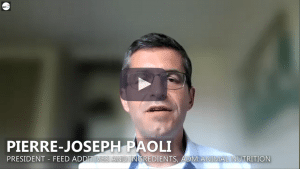ADM Launches New Sweetening Feed Solutions for Piglets
November 21, 2022, Rolle, Switzerland – ADM (NYSE: ADM), a global leader in human and animal nutrition, today announced the launch of two products under its SUCRAM range, an in-feed sweetening solution for livestock species. Developed by ADM’s global feed additives business, Pancosma, SUCRAM M’I Sweet and SUCRAM Specifeek are sweeteners designed to improve the palatability of feed for young animals – particularly weanling pigs. Palatants and sweeteners are useful nutrition solutions to improve feed intake and enhance efficiencies for producers while also supporting animal health and well-being.
“Significant diversity exists between the sweet taste receptors among different species, impacting the perception of sweetness,” said Fabio Catunda, ADM Global Swine Commercial Director. “What is sweet for one species may not be perceived as sweet in another species due to these inter-species differences. This is critical to understand when developing effective sweetening products such as SUCRAM.”
An ongoing collaboration between ADM’s nutrition experts and molecular physiology and biochemistry scientists at the University of Liverpool is expanding industry knowledge of the function of sweet taste receptors in animals.
Learning opportunity: Learn more about the research findings in our Webinar:
NEW Species-specific approach to sweeteners for animal feed
December 8th 3pm-4pm CET
These new additions to ADM’s SUCRAM range were specifically developed to activate the swine sweet taste receptors, with a focus on piglets at weaning. In-feed sweeteners have demonstrated to be an effective attractant to encourage feed intake at the weaning stage, as piglets make the transition from liquid to solid feed.
Both SUCRAM M’I Sweet and Specifeek are saccharin-free and, as part of the product development process, were tested in an in-vitro swine sweet taste receptor model. After years of research, these products also may have functional benefits in encouraging feed intake during a stressful period, optimizing nutrient absorption and supporting gut health and maturation to promote ongoing growth and performance in pigs.
SUCRAM products are available across the globe in more than 45 countries. Specifeek and M’I Sweet will initially be launched in Europe.
Related articles
Discover Pancosma sweetener solutions
Combinations of feed additives as alternative to Zinc oxide in piglet diets
References
- Sterk A, Schlegel P, Mul AJ, Ubbink-Blanksma M and EMAM. Bruininx, 2008. Effects of sweeteners on individual feed intake characteristics and performance in group-housed weanling pigs. Journal of Animal Science. 86:2990-2997.
- Shirazi-Beechey SP, Moran AW, Bravo D and M. Al-Rammahi, 2011. NONRUMINANT NUTRITION SYMPOSIUM: Intestinal glucose sensing and regulation of glucose absorption: Implications for swine nutrition. Journal of Animal Science. 89(6): 1854-1862.
- Furness, J.B. et al., 2013. The gut as a sensory organ. Nature Reviews. Gastroenterol. Hepatol. 10(12):729.
- 2016, Connor et al, DAE : Glucagon-like peptide 2 and its beneficial effects on gut function and health in production animals
- Daly K, Moran AW, Al-Rammahi M, Weatherburn D, Shirazi-Beechey SP, 2021. Non-nutritive sweetener activation of the pig sweet taste receptor T1R2-T1R3 in vitro mirrors sweetener stimulation of the gut-expressed receptor in vivo. Biochemical and Biophysical Research Communications. 542: 54-58.



